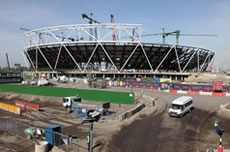Many of the blogs featured here have considered the role that engineers have in ensuring that the UK meets its 2050 carbon reduction targets. Much attention is focused on the operation of buildings, i.e. the CO2 associated with heating, cooling, lighting etc. But we must also consider the carbon associated with putting the building there in the first place.
Earlier this year the world quietly passed the somewhat symbolic mark of atmospheric CO2 rising above 400 parts per million. This is the first time our planet has been in this position for several hundred millennia and certainly before humans existed. This somewhat abstract threshold is important because it marks yet another point in the continued upward rise of atmospheric CO2, a situation which will have to be addressed if we are to avoid the potentially serious situation of uncontrolled climate change and global average temperature rises of 2°C or more.
This agenda makes climate change perhaps the defining environmental challenge of our time. In the UK, national legislation has been enacted with the Climate Change Act of 2008 which sets a legally binding objective to reduce by 2050 the UK greenhouse gas (GHG) emissions by 80 per cent as set against a baseline 1990 level.
“The issue is not just about meeting that reduction target. More critical still will be the reduction trajectory we take to get there
The issue is more even more complex because it is not just about meeting that 80 per cent reduction target, but more critical still will be the reduction trajectory we take to get there; the area under the curve as it were. Limiting total emissions within a discrete budget will become an increasingly pressing issue with time; and there is not much of this. Earlier this year the International Energy Agency quoted that “to keep open a realistic chance of meeting the 2°C target, intensive action is required before 2020”.

Against this back drop what is the practicing engineer to do, what does it mean for your industrial sector and the everyday engineering challenges you face? This was the context set by the UK Green Construction Board (GCB), a forum for UK Government and the construction industry to drive forward collaboratively the actions set out in the sector’s Low Carbon Construction Action Plan. The reality of this however is that the plan has:
· No specific reduction target for the built environment
· No clear understanding of where GHG emissions reside
· No clear understanding of mitigation responsibilities
· No detailed plan of action for built environment and its stakeholders
This represents an immense and complex problem for a sector that operates over such long life cycles, is as diverse as residential to railways, and relies on a supply chain as different as cement manufacturing to the UK energy grid (for example).
|
|
The core components of the GCB programme were to develop a whole sector GHG model for the construction and operation of buildings and infrastructure that could show where carbon emissions arise together with the relative sub-sector responsibilities for these emissions. Tracking forward it also established scenarios for future reduction and tested the deployment of different policy ideas and technical solutions to bring down emission levels.
The work brought this together in a routemap for how the industry and its stakeholders might work to meet the 80% target level. The end outcomes can be explored at the GCB carbon routemap website including a tool for scenario modelling and an infographic that summarises the issues, the size of the industry challenge, and presents a scenario for achieving 80% reduction.
“Delivering a carbon reduction strategy of this scale will require comprehensive response by government and industry
Delivering a carbon reduction strategy of this scale will require comprehensive response by government and industry. Change in business practice as well as policy and legislative instruments will be necessary. Engineered solutions from all disciplines will be central to delivering change; this work provides a platform to consider these changes. Detailed responses will be needed for how we design and construct new buildings and infrastructure, as well as retrofit and upgrade our existing assets. Significant energy efficiency gains will be needed to reduce operational energy demand and the carbon associated with this. But the supply chain must also be tackled. Emissions from the manufacture of materials will become far more significant, perhaps as much as 40% of emissions by 2050. Whilst materials efficiency in design, substitution strategies, and alike will have a role, there will also be a necessity to develop entirely new production technologies for a world that cannot afford carbon intensive industry.
As engineers we advise on the design, construction, operation and acquisition of infrastructure and property assets. We will be a key enabler of transitioning the UK to a low carbon future and it is our professional duty to consider the drivers discussed here and work to deliver the changes that will be necessary.





April 1886: the Brunkebergs tunnel
First ever example of a ground source heat pump?